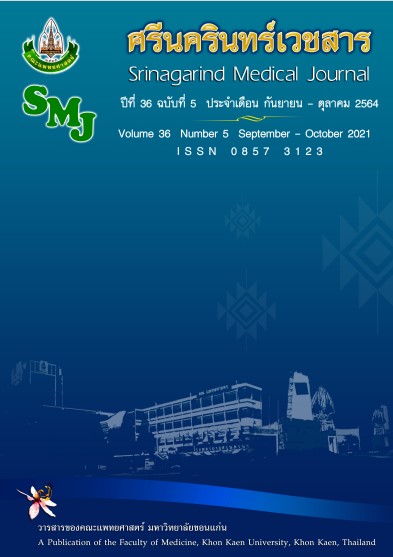Down Syndrome Screening Outcomes in Advanced Maternal Age Pregnant Women at Roi Et Hospital
Keywords:
Advanced maternal age;Down syndrome; TerminationAbstract
Background and ObjectiveDown syndrome screening in elderly women is very important to identify fetal abnormal chromosome, especially Down syndrome. The objective was to study the Down syndrome screening outcomes in advanced maternal age pregnant women at RoiEt Hospital.
MethodsThis study wasretrospective cohort study.All data were collected from medical records of advanced maternal age pregnancy with age > 35 years, 14-18 weeks gestation agethat abnormal Quadruple tests were providing for amniocentesis at Roi Et Hospital during January 2019 to December 2020. The descriptive statistics were used for all data analyzed.
Results One hundred and seventy-one of pregnant women were enrolled, which mean age and mean gestational age were 37.61 ± 3.31 years, and 14.56 ± 0.48 weeks, respectively . The Quadruple test were found high risk for Down syndrome 90.64%, high risk for Edwards syndrome 4.09%, high risk for Patau syndrome 1.75%, and high risk for Neural tube defect 7.02 %. Amniocentesis was performed in 157cases for chromosomal study at Roi Et Hospital.The chromosome study were found normal karyotype 96.17%,Down syndrome 1.91% (47,XX+21 2 cases and 47, XY+21 1case), 47,XXX 1.27%,46,X,inv(Y)(p11.2q11.23) 0.65%, and Ultrasound examination revealed anencephaly in 1 case. The 3 cases of advanced maternal age pregnancy who were diagnosed with Down syndrome had agreed for terminate.
Conclusion: This study revealed that advanced maternal age pregnancy has screening by Quadruple test positive and confirmed diagnosed for Down syndrome 3 cases. All of them consented for termination process.
References
2. Weijerman ME, de Winter JP. Clinical practice. The care of children with Down syndrome Eur J Pediat 2010;169(12): 1445–52.
3. Lozano R, Naghavi M, Foreman K, Lim S, Shibuya K, Aboyans V, et al. Global and regional mortality from 235 causes of death for 20 age groups in 1990 and 2010: a systematic analysis for the Global Burden of Disease Study 2010. Lancet Lond Engl 2012;380(9859): 2095–128.
4. GBD 2015 Disease and Injury Incidence and Prevalence Collaborators. Global, regional, and national incidence, prevalence, and years lived with disability for 310 diseases and injuries, 1990-2015: a systematic analysis for the Global Burden of Disease Study 2015. Lancet Lond Engl 2016;388(10053): 1545–602.
5. Parker SE, Mai CT, Canfield MA, Rickard R, Wang Y, Meyer RE, et al. Updated National Birth Prevalence estimates for selected birth defects in the United States, 2004-2006. Birt Defects Res A Clin Mol Teratol 2010;88(12): 1008–16.
6. Malt EA, Dahl RC, Haugsand TM, Ulvestad IH, Emilsen NM, Hansen B, et al. Health and disease in adults with Down syndrome. Tidsskr Den Nor Laegeforening Tidsskr Prakt Med Ny Raekke 2013;133(3):290–4.
7. Marttala J, Yliniemi O, Gissler M, Nieminen P, Ryynanen M. Prevalence of Down’s syndrome in a pregnant population in Finland. Acta Obstet Gynecol Scand 2010;89(5): 715–7.
8. Siripoonya P, Tejavej A. Congenital abnormalities in the early neonatal period: ten years incidence at Ramathibodi Hospital. J Med Assoc Thail Chotmaihet Thangphaet 1980;63(10): 544–7.
9. Dissaneevate S, Jaruratanasirikul S, Chanvithan P, Janjindamai W. Congenital malformations of newborns at Songklanagarind Hospital. Songklanagarind Med J 2003;21(4): 267–76.
10. Jaruthamsophon K, Sriplung H, Charalsawadi C, Limprasert P. Maternal age-specific rates for trisomy 21 and common autosomal trisomies in fetuses from a single diagnostic center in Thailand. PloS One 2016;11(11): e0165859.
11. Jaruratanasirikul S, Kor-Anantakul O, Chowvichian M, Limpitikul W, Dissaneevate P, Intharasangkanawin N, et al. A population-based study of prevalence of Down syndrome in Southern Thailand. World J Pediatr WJP 2017;13(1): 63–9.
12. Jaruratanasirikul S, Limpitikul W, Dissaneevate P, Booncharoen P, Tantichantakarun P. Comorbidities in Down syndrome livebirths and health care intervention: an initial experience from the birth defects registry in Southern Thailand. World J Pediatr WJP 2017;13(2): 152–7.
13. Morris JK, Mutton DE, Alberman E. Revised estimates of the maternal age specific live birth prevalence of Down’s syndrome. J Med Screen 2002;9(1): 2–6.
14. Coppedè F. Risk factors for Down syndrome. Arch Toxicol 2016;90(12): 2917–29.
15. Yang Q, Rasmussen SA, Friedman JM. Mortality associated with Down’s syndrome in the USA from 1983 to 1997: a population-based study. Lancet Lond Engl 2002;359(9311): 1019–25.
16. Screening for Fetal Down Syndrome [Internet]. [cited 2021 May 19]. Available from: https://w1.med.cmu.ac.th/obgyn/index.php?option=com_content&view=article&id=428:screening-for-fetal-down-syndrome&catid=40&Itemid=482
17. กลุ่มอาการดาวน์. In: วิกิพีเดีย [Internet]. 2019 [cited 2021 May 19]. Available from: https://th.wikipedia.org/w/index.php?title=%E0%B8%81%E0%B8%A5%E0%B8%B8%E0%B9%88%E0%B8%A1%E0%B8%AD%E0%B8%B2%E0%B8%81%E0%B8%B2%E0%B8%A3%E0%B8%94%E0%B8%B2%E0%B8%A7%E0%B8%99%E0%B9%8C&oldid=8601852
18. กลุ่มอาการดาวน์ซินโดรม (Down’s syndrome) [Internet]. healthsmile.co.th. [cited May 19, 2021]. Available from: https://healthsmile.co.th/Knowledge/กลุ่มอาการดาวน์ซินโดรม-(Down’s-syndrome)
19. Lozano R, Naghavi M, Foreman K, Lim S, Shibuya K, Aboyans V. Global and regional mortality from 235 causes of death for 20 age groups in 1990 and 2010: a systematic analysis for the Global Burden of Disease Study 2010. Lancet2012;380(9859): 2095-128
20. Natoli JL, Ackerman DL, McDermott S, Edwards JG. Prenatal diagnosis of Down syndrome: a systematic review of termination rates (1995–2011). Prenat Diagn 2012;32(2): 142–53.
21. Global, regional, and national incidence, prevalence, and years lived with disability for 310 diseases and injuries, 1990–2015: a systematic analysis for the Global Burden of Disease Study 2015. Lancet Lond Engl 2016;388(10053): 1545–602.
22. Revised estimates of the maternal age specific live birth prevalence of Down’s syndrome. J Med Screen 2002;9(1): 2–6.
23. Mansfield C, Hopfer S, Marteau TM. Termination rates after prenatal diagnosis of Down syndrome, spina bifida, anencephaly, and Turner and Klinefelter syndromes: a systematic literature review. Prenat Diagn 1999;19(9): 808–12.
24. Choi H, Riper MV, Thoyre S. Decision Making Following a Prenatal Diagnosis of Down Syndrome: An Integrative Review. J Midwifery Womens Health 2012;57(2):156–64.
25. Wald NJ, Huttly WJ, Hackshaw AK. Antenatal screening for Down’s syndrome with the quadruple test. Lancet Lond Engl 2003;361(9360): 835–6.
26. Kwon JY, Park IY, Kwon S-M, Kim CJ, Shin JC. The quadruple test for Down syndrome screening in pregnant women of advanced maternal age. Arch Gynecol Obstet 2012;285(3): 629–33.
27. Canick J. Prenatal screening for trisomy 21: recent advances and guidelines. Clin Chem Lab Med 2012;50(6): 1003–8.
28. Tabor A, Alfirevic Z. Update on Procedure-Related Risks for Prenatal Diagnosis Techniques. Fetal Diagn Ther 2010;27(1): 1–7.




